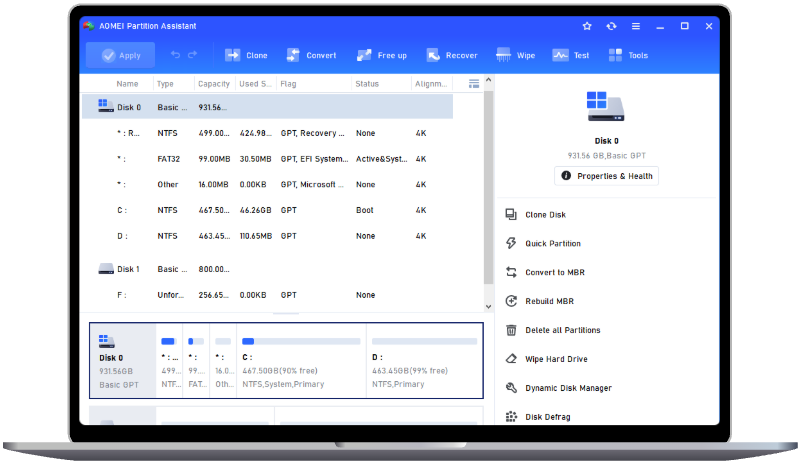How to Format USB with Multiple Partitions?
Using a USB drive with multiple partitions gives you greater control over your storage space. But how do you format a USB drive with multiple partitions? This article walks you through the entire process, helping you easily manage your storage device.
USB drives are versatile storage devices commonly used for transferring files, creating backups, or even booting operating systems. Many users choose to create multiple partitions on their USB drives for better organization or to run separate operating systems. However, there are times when you may need to format the USB drive—whether to prepare it for a new use, resolve errors, or reconfigure its partitions. The process can be a bit more involved than formatting a standard single-partition USB drive, but don’t worry! Here's a step-by-step guide to help you through the process.
How to Format a USB with Multiple Partitions?
For an easy and efficient formatting solution, we recommend using AOMEI Partition Assistant (compatible with Windows 11, 10, 8.1, 8, and 7). This user-friendly and professional disk management software allows you to format USB partitions to another different file system, such as NTFS, exFAT, Ext 4, Ext3, Ext2, or FAT32. Even without extensive computer knowledge, you can easily manage your drive through its user-friendly interface.
➤ Before You Do
• Create a backup of all the important files and data that you want to keep.
• Close any programs that may be running from the USB drive to prevent data corruption.
Once you’re ready, follow these steps to format your USB drive with multiple partitions:
Step 1. Connect your USB to your computer.
Step 2. Install and launch AOMEI Partition Assistant; right-click the partition you want to format and select "Format Partition".
Step 3. In the pop-up window, select the file system as needed and click "OK".
Step 4. Finally, click "Apply" and "Proceed" to commit the operation.
Additional Tips for USB Management
➤ Merge Multiple Partitions into One
If you no longer require multiple partitions on your USB drive, merging them into a single partition can help simplify and optimize your storage. AOMEI Partition Assistant not only allows you to format a USB drive with multiple partitions but also enables you to combine two partitions into a larger one. Here’s how you can merge your USB partitions:
Step 1. Launch AOMEI Partition Assistant, right-click the partition (here we take C: as an example) you want to merge, and click "Advanced" > "Merge Partitions".
Step 2. In the pop-up window, select the partitions you want to merge and click "OK" to continue.
Alternatively, you can add unallocated space into a partition. For example, merging the D: partition and unallocated space.
Step 3. Finally, click "Apply" and "Proceed" to commit the operation.
➤ Create Multiple Partitions at Once
If you are seeking an easier method to create partitions on USB, consider trying the “Quick Partition” feature to create multiple partitions at once! Here are the steps:
Step 1. Right-click on the USB drive and select “Quick Partition”.
Step 2. In the pop-up window, set partition count, default size, disk types, and other information.
Step 3. When all the settings are done, click "Start Partitioning" to perform one-key quick partition.
Final Words
In this post, we've covered how to format a USB drive with multiple partitions. With AOMEI Partition Assistant, the process can become simple and efficient. This tool also offers a range of additional disk management features, such as USB drive cloning, USB flash drive wiping, and allocating free disk space. However, none of these benefits will be available unless you download and start using the software. So, go ahead and give it a try!
FAQs:
Q1: Can all USB drives support multiple partitions?
Most USB drives support multiple partitions, but the ability to create and use them depends on the file system (e.g., FAT32, exFAT, NTFS) and the operating system you’re using. Some older systems or devices may only recognize the first partition.
Q2: Why can’t I see all partitions on my USB drive after formatting?
Some operating systems (e.g., macOS or older Windows versions) may only recognize the first partition on a USB drive. To fix this, ensure the USB is formatted with a compatible file system and that your OS supports multiple partitions.
Q3: Can I resize partitions on a USB drive?
Yes, you can resize partitions using tools like AOMEI Partition Assistant. Be cautious, as resizing partitions may result in data loss. It is advised to back up essential data before proceeding.


